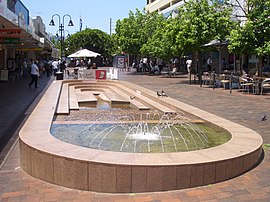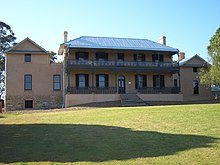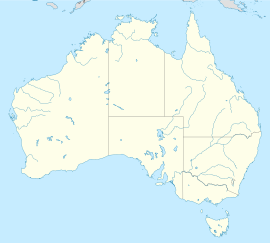Eastwood, New South Wales
| Eastwood Sydney, Error: unknown |state= value (help) | |||||||||||||||
|---|---|---|---|---|---|---|---|---|---|---|---|---|---|---|---|
 Fountain in Rowe Street mall | |||||||||||||||
| Coordinates | 33°47′25″S 151°04′54″E / 33.790362°S 151.081731°E | ||||||||||||||
| Population | 14,428[1] | ||||||||||||||
| Postcode(s) | 2122 | ||||||||||||||
| Standort | 17 km (11 mi) north-west of Sydney CBD | ||||||||||||||
| LGA(s) | City of Parramatta, City of Ryde | ||||||||||||||
| State electorate(s) | Epping, Ryde | ||||||||||||||
| Federal division(s) | Bennelong | ||||||||||||||
| |||||||||||||||



Eastwood is a suburb of Sydney, in the state of New South Wales, Australia. Eastwood is located 17 kilometres north-west of the Sydney central business district in the local government areas of the City of Ryde and the City of Parramatta. Eastwood is in the Northern Suburbs region.
Originally thought to have been inhabited by the Wallumedegal Aboriginal tribe, who lived in the area between the Lane Cove and Parramatta Rivers, the area was first settled by Europeans shortly after the arrival of the First Fleet in 1788, from land grants to Royal Marines and NSW Corps, and was named "Eastwood" by an early Irish free settler, William Rutledge. Today it is a large urban centre in the north of Sydney of over 14,000 people, with a large shopping area. Eastwood has a large population of Asian descent with immigrants from China and South Korea transforming the commercial precinct in the past decade.
Eastwood is famous for the Granny Smith Apple, which was first grown in the suburb. Every October, the oval and cordoned-off streets become the grounds for the annual Granny Smith Festival, a celebration of the icon with fairground rides, market stalls, street theatres, parades, an apple-baking competition and a fireworks spectacular at the Upper Eastwood Oval. In recent years the festival has been influenced by the substantial Asian immigrant communities, with Chinese dragon dancers in the Grand Parade and Chinese stallholders. Conversely, Eastwood's annual Chinese New Year Celebrations have broadened its appeal by incorporating concurrent Korean New Year traditions, and have accordingly been renamed the Lunar New Year Festivities.[2]
Geography
Eastwood is located at the edge of the Hornsby Plateau with the suburbs of Dundas Valley and Denistone on its western and southern sides, respectively, as the land falls away down to the Cumberland Plain. To the north, Eastwood is bounded by the transport hub of Epping and to its east Marsfield which shares the same postcode of 2122. The suburb is predominantly residential with the main shopping area of Eastwood centred between Rowe Street and Rutledge Street around the railway line.
History
The Wallumedegal Aboriginal tribe lived in the area between the Lane Cove River and Parramatta River, which was known as Walumetta. The area was originally heavily timbered.[3]
The area was first settled by Europeans shortly after the arrival of the First Fleet in 1788 and was part of the Field of Mars. The area of Eastwood was originally granted between the years of 1790 and 1803 to marines and the NSW Corps. John Love, a private was granted 90 acres (36 ha) here in 1794, described as North Brush, in the Field of Mars Common. The land was then acquired by William Kent who already held land in what is now Epping. The land was purchased by William Rutledge for 288 pounds in 1835, who built 'Eastwood House' in 1840. This house is now part of Marist College Eastwood. In 1863 Edward Terry purchased the estate and upon his death in 1905, the estate was sub-divided.
In 1886, the railway line from Strathfield to Hornsby was opened, with a station here originally called Dundas. This was changed a year later to Eastwood, named after the Eastwood Estate.
The commercial centre underwent a major upgrade in the early 1980s. Rowe Street, which originally ran across the railway line through a level crossing was turned into a mall between The Avenue and West Parade, and the 1940s bridge built in First Avenue for crossing traffic was replaced with a six-lane bridge. This bridge was to service the planned County of Cumberland Scheme, Eastwood County Road (linking Eastwood with Macquarie Park), a road project in the local area which has been controversial among locals.[4]
Development
The City of Ryde Council has granted development consent to the development application number: 936/2007 to build a new Eastwood Shopping Centre in 152-188 Rowe Street & 3-5 Rutledge Street, Eastwood.
The main components of the development are:
- 13,500m2 of net usable retail floor area, over two levels
- 1,600m2 of net usable commercial floor area (not including the restaurant and childcare centre as given below)
- 1,700m2 of net usable floor area for a restaurant
- 800m2 of net usable floor area for a childcare centre
- A total of 970 car parking spaces, 676 of which are associated with the proposed retail/commercial uses and 294 with the proposed residential units.
Commercial area
The Eastwood commercial district is located around Eastwood railway station. The Eastwood Shopping Centre is a shopping mall, which includes major retailer Woolworths is located in the town centre and opens on to the Eastwood Plaza. The Plaza features a fountain and several cafes with outdoor seating. Eastwood is becoming well known as an Asian shopping precinct, with speciality stores, supermarkets and many restaurants run by Chinese and Korean retailers.[5] The ethnic background of its shoppers has created a hub of mainly Chinese, Vietnamese, Cantonese and Korean restaurants and eateries in the area.
Transport
Eastwood is relatively well served by public transport. Eastwood railway station is located on the Northern Line. The station opened in 1886,[6] and it takes approximately 30–35 minutes to travel to Central. Intercity services also service Eastwood station between Central, Newcastle and the Central Coast region.
Numerous bus services also operate from the small interchange outside the station. These include the 545/550 route between Parramatta and Chatswood, the 544 route between Auburn and Macquarie University, and the 515/X15 service to the Sydney CBD. Eastwood is also served well by roads, and is located close to the trunk routes of Metroad 6 (Marsden Road), and Victoria Road.
Landmarks
- Brush Farm House - former home of Gregory Blaxland, one of the explorers of the Blue Mountains.
- Eastwood House - the former home of Edward Terry, the original landowner of the estate on which Eastwood is now built.[7]
Eastwood once featured a lake which gave the names Lakeside Road and The Lakeside Road Uniting Church.[8] This lake was later converted to an oval which is used for soccer matches and by local schools. Eastwood is also home to the Corrective Services Academy, a training centre for prison officers.



Forest Reserves
Darvall Park and Brush Farm Park are examples of remnant forest areas in the Eastwood district. Volunteers and professional bush regenerators have worked to preserve the Blue Gum high forest and rainforest in these areas. The largest Tree Heath known anywhere in existence occurs at Brush Farm park. Other notable plants include Native Crabapple, Jackwood and Red Olive Berry. Despite being within a large city, Brush Farm has remarkable fauna, including the Powerful Owl, Emerald Dove, Eastern Whipbird, Satin Bowerbird and the Green Tree Snake.
Housing
Housing consists of many Californian Bungalow and Federation homes, especially in streets located closer to the station. More post World War II homes can be seen further from the station, especially to the north of Terry Road. While most of Eastwood is residential, with one or two-storey detached houses and villas, the area surrounding the town centre boasts buildings up to seven storeys high. In 2006 the City of Ryde developed a Control Plan for the Eastwood Town Centre, which includes the provision of buildings of up to ten storeys high in the shopping and railway areas.[9] Former industrial parts of the suburb are also undergoing redevelopment. The former brickworks site is being converted into a housing estate.[10][11]
Churches
- Christ Evangelical Center of Australia (CECA)
- Eastwood Baptist Church
- Exclusive Brethren Church
- Lakeside Road Uniting Church (former Methodist Church)
- Macquarie Chapel - Pastor Richard Quadrio started the church in 2001. It is combined with Macquarie Presbyterian Church.[12]
- St Andrew's Uniting Church - (former Presbyterian Church)
- St Kevin's Catholic Church - this church was completed in 1994 to replace the original church, which is now the library of the local Catholic school (St Kevins.)[13]
- St Philip's Anglican Church was founded over 100 years ago, and has met in the current church building since 1907.[14]
- Cornerstone Presbyterian Community Church Eastwood (meets at Eastwood Heights Public School)
- St Georges Anglican Church, Balaclava Road, Eastwood Heights
- St Dunstan's Anglican Church, Lovell Road, Denistone East
Schools
Primary Schools
- Eastwood Heights Public School[15]
- Eastwood Public School[16]
- St Kevins Eastwood (Catholic primary school)[17]
- Denistone East Public School (Although it is named Denistone East Public School, it is located in Eastwood.)
High Schools
Culture and events
Eastwood is well known as the place where the Granny Smith apple was first grown. This is celebrated each October with the Granny Smith Festival which attracts over 60,000 people each year.
Population
Today it is a large urban centre in the north of Sydney of over 14,000 people.[1] Over the past few decades Eastwood has become increasingly multicultural.[18] Migrants from southern Europe countries such as Italy and Greece began settling here and at Carlingford from the 1960s. From the early eighties to the late nineties, many Afghans and Iranians settled in the area. Since the beginning of the 1990s, a relatively high percentage of immigrants from Hong Kong, other parts of China, Korea and a few other southeast-Asian groups have settled in the area. In the 2006 census, over 50% of residents were born overseas.[1]
Notable Residents
The band All Mankind, best known for the songs "Break the Spell" and "If You Really Mean It, Shake Your Head Like A Polaroid Picture" are all Eastwood residents.
Former Residents
- Aziz Shavershian - Bodybuilder, internet celebrity, personal trainer and model.
- Geoffrey Robertson - Human rights lawyer, academic, author and broadcaster.
- Reg Campbell - Portrait painter and self-taught artist.
References
- ^ a b c Australian Bureau of Statistics (25 October 2007). "Eastwood (State Suburb)". 2006 Census QuickStats. Retrieved 2008-03-23.
- ^ "Mixing it up in Bennelong" Accessed 11 August 2011.
- ^ The Book of Sydney Suburbs, Compiled by Frances Pollon, Angus & Robertson Publishers, 1990, Published in Australia ISBN 0-207-14495-8, page 92
- ^ "Ozroads: Eastwood County Road", 2004-2007. Accessed 6 July 2007.
- ^ Maher, Stephen, "Goodbye to the Eastwood of old", Northern District Times, 11 April 2007, page 14. Accessed via Factiva on 10 July 2007.
- ^ Bozier, Rolfe, "New South Wales Railways: Eastwood Railway Station". Accessed 4 July 2006.
- ^ City of Ryde, "A Brief History of Ryde", 2007. Accessed 6 July 2007.
- ^ Giuliani, Bernard, (1988) Eastwood Scrapbook, p.1? Marist Publishers: Drummoyne, NSW. ISBN 0-949807-64-8.
- ^ City of Ryde, "Development Control Plan - Part 4.1 Eastwood Town Centre", 2006, pp. 11–12. Accessed 4 July 2007.
- ^ Rumble, Chantal, "Brick pit fill bakes anger", Northern District Times, 21 May 2003, p. 2.
- ^ "Life at Newthorpe". Accessed 4 July 2007.
- ^ "Presbyterian Churches of New South Wales: Macquarie Chapel Presbyterian". Accessed 6 July 2007.
- ^ "St Kevins Primary School: History". Accessed 6 July 2007.
- ^ "St Philips Anglican Church Eastwood" Accessed 20 October 2010.
- ^ Eastwood Heights Public School
- ^ Eastwood Public School
- ^ St Kevins School
- ^ Megalogenis, George, "Asian influence spices up contest", The Australian, 27 February 2007, p. 11. Accessed via Factiva on 10 July 2007.

